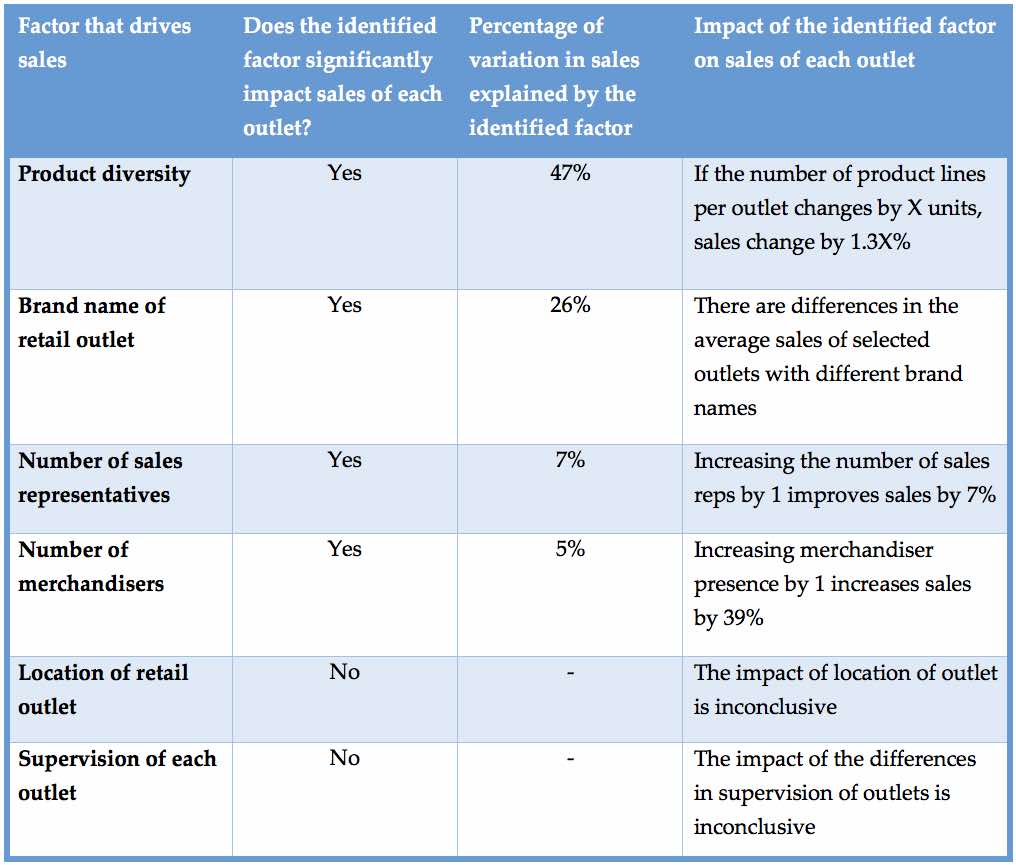Case study: Key Drivers of Retail Sales Performance

We approached a major fast-moving consumer goods (FMCG) company operating in Zimbabwe with the intention to help management understand why some of their retail outlets performed above expectation while other outlets performed below expectations.
The aim was to identify controllable and non-controllable factors that influence the performance of each outlet. The identification of controllable factors would then lead to strategies that manipulate those factors in order to optimize each retail outlet’s performance. We sought to answer the following questions:
- Does the diversity of product lines in each outlet influence sales performance?
- Does location have an impact on the sales of each retail outlet?
- Does the presence of certain employees (e.g. sales representatives, merchandisers, merchandising supervisors) have an impact on the sales of each retail outlet?
- Does the psychometric profile of employees influence the performance of their respective retail outlets?
- Does the brand name of each retail outlet attract more (or less) customers leading to differences in sales?
Answers to these questions would lead to informed decisions when deploying merchandise. Other factors that have to be taken into account are the effects of location, product diversity, the presence and profile of human capital, as well as whether or not some brands of outlets should receive more attention than others.
How We Intervened
We worked together with the retailer’s Human Resources Department and we gathered data to incorporate in our analysis. The initial stage of our analysis involved building a descriptive analytics model using regression techniques to identify the major drivers behind the differences in sales performance of each outlet.
In the second stage we examined the outcome of the descriptive model to see how we could optimize sales performance. The third stage involved matching insights with appropriate recommendations aimed at improving the retailers’ overall performance.
Initial Phase
Using our descriptive analytics model, our initial findings are as follows:
As seen in the table above, our descriptive analytics model managed to explain approximately 86% of the variation in sales. In other words, we identified four factors that significantly impact the sales performance of each retail outlet. These factors can be used to accurately explain why some outlets meet set expectations while others do not.
Manipulating the presence of merchandisers to improve profit
Although the differences in merchandiser presence in each outlet explain only 5% of the differences in sales performance (as suggested by our model), changing the presence of merchandisers in an outlet from one to two has a greater impact on sales than other controllable factors.
This implies that the FMCG company benefits from increasing the presence of merchandisers in all its outlets. Merchandiser presence could be improved by either rotating the available merchandisers so that each outlet has enough merchandisers, or by recruiting externally, if funds permitted.
Manipulating product diversity and the number of sales representatives per outlet
Product diversity turned out to be the factor that explains most of the variation in outlet performance. This retailer distributes merchandise through contractual agreements on shelf space with wholesalers, supermarkets and other shop owners.
Some outlets had only one product line whereas others had more than a thousand. Outlets that fall in the latter category consistently outperformed outlets with less product diversity. The table above shows that if the number of product lines changes by X units, sales change by 1.3X%. This implies that improving an outlet’s product diversity by adding, for example, one more product line improves an outlet’s sales by 1.3%. This number is practically insignificant. However, when ten new product lines are introduced in an outlet, this would translate into a 13% increase in sales performance, which is a major improvement.
For this particular retailer, product diversity is linked to the number of sales representatives who frequent each shop. Therefore, the retailer needs to do a cost-benefit analysis since introducing more product lines means more sales representative presence. This results in more wages or overtime hours.
Taking advantage of the different brand names the outlets belong to
Among all the outlets, some outlets had better average sales because of the brand names they belong to. The implication of this is that when the retailer introduces new products – after having taken into consideration e.g. the socioeconomic class of the outlet’s clientele – he would consider trying brand names that consistently outsell the other brand names to ensure adequate market penetration.
Not focusing on the wrong things
According to our analysis, outlets with different merchandising supervisors had no significant differences in sales performance. Such a scenario is highly unlikely. The expectation is that some employees excel while others fall behind. This result suggests that the way the role of the merchandising supervisor was structured was not contributing to the business. Also, any form of remuneration for these supervisors that is linked to the differences in their respective outlets’ performance, was erroneous.
Broadly speaking, average performance of outlets in urban areas could not be differentiated from the average performance of outlets in peri-urban and rural areas. This means that, when deploying merchandise, merchandisers and sales representatives, all outlets would have to be treated equally, without preferential treatment driven by location.
The Second Phase

Having identified that manipulating the presence of merchandisers in an outlet greatly improves sales, we sought to identify the attributes of the ideal merchandiser. Should the FMCG company choose to recruit, it would not only need the right number of merchandisers, but also merchandisers with the ideal profile.
We sampled merchandisers from selected outlets and invited them over for psychometric profiling. This allowed us to measure the cognitive abilities and personality traits of each merchandiser. We also gathered demographic information (e.g. age, marital status etc.) on all tested merchandisers to establish if there is a link between selected demographic factors and the performance of the merchandisers’ respective outlets.
We identified three personality traits which, in the right combination, explain 20% of the variation in performance of each outlet. In other words, the FMCG company now knows the personality traits of its merchandisers that are associated with higher performance.
The three personality traits are defined as follows:
- Striving for social acceptance describes a person’s striving for social status and recognition. The higher the percentile rank, the more important it is for the person to feel socially accepted and to behave accordingly.
- Aspiration level – This dimension indicates whether the respondent tends to set realistic or unrealistic goals for him or herself (e.g. with regard to the quantity of work that one can carry out or to the accuracy and thoroughness one aims at). Achievement-motivated people set realistic but ambitious goals that somewhat exceed their previous achievements. Goals of this type are indicated by medium to high percentile ranks.
- Extroversion – The merchandiser enjoys being around and interacting with people. He/she would rather take charge than be reserved.
The insight above is invaluable when the company wants to recruit new merchandisers or take merchandisers that are already in the system through training.
The Way Forward
Instead of linking psychometric profiles to the performance of outlets, it would be ideal to link each psychometric profile to each merchandiser’s performance appraisal score. However, at the time, the retailer’s performance appraisal system for merchandisers was not reflecting true merchandiser performance.
When monitoring if the identified psychometric attributes are indeed vital to the company’s performance, we worked hand in hand with the company’s HR manager and merchandising manager to draft a new performance appraisal system. This system would not only accurately measure merchandiser performance, but also improve the contribution of merchandising supervisors to the business.
The objective is to link performance appraisal scores from this new system to each merchandiser’s psychometric profile.
Conclusion

By following the stages of this project, we identified critical factors that are crucial to the performance of this FMCG company’s outlets by using analytics methods. We also identified factors that did not significantly contribute to differences in performance. The combination of all these insights provided an invaluable guide to decide which factors the company strategy should or should not focus on.
We continued our interrogations and found that psychometric tests where indeed a valid way for recruitment and developing merchandisers.
We conclude that basing your organisation’s strategy on scientific methods and moving on to validate the insights that subsequently come from this approach, is of utmost importance.
This case study demonstrates the benefits of applying people analytics to the day-to-day business. By applying analytics and combining these analytics with financial outcomes we were able to optimize the business and improve sales performance.
Memory is Managing Consultant of Industrial Psychology Consultants(Pvt). He has extensive experience in human resources management, in both line function and consultancy services. With IPC Consultants his aim is to maximise returns on human capital. Contact Memory at [email protected] or connect with him on LinkedIn
Weekly update
Stay up-to-date with the latest news, trends, and resources in HR
Learn more
Related articles
Are you ready for the future of HR?
Learn modern and relevant HR skills, online













